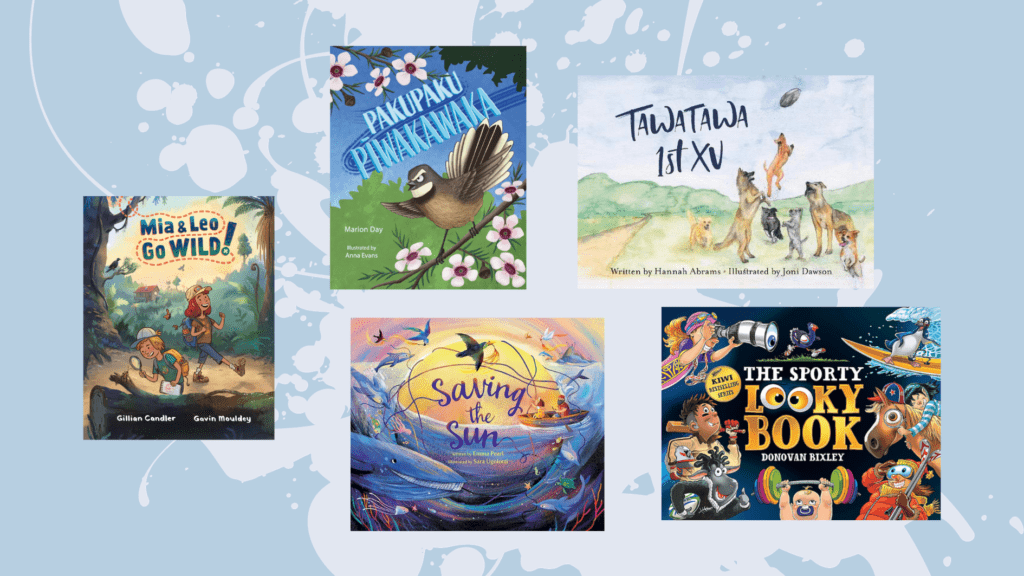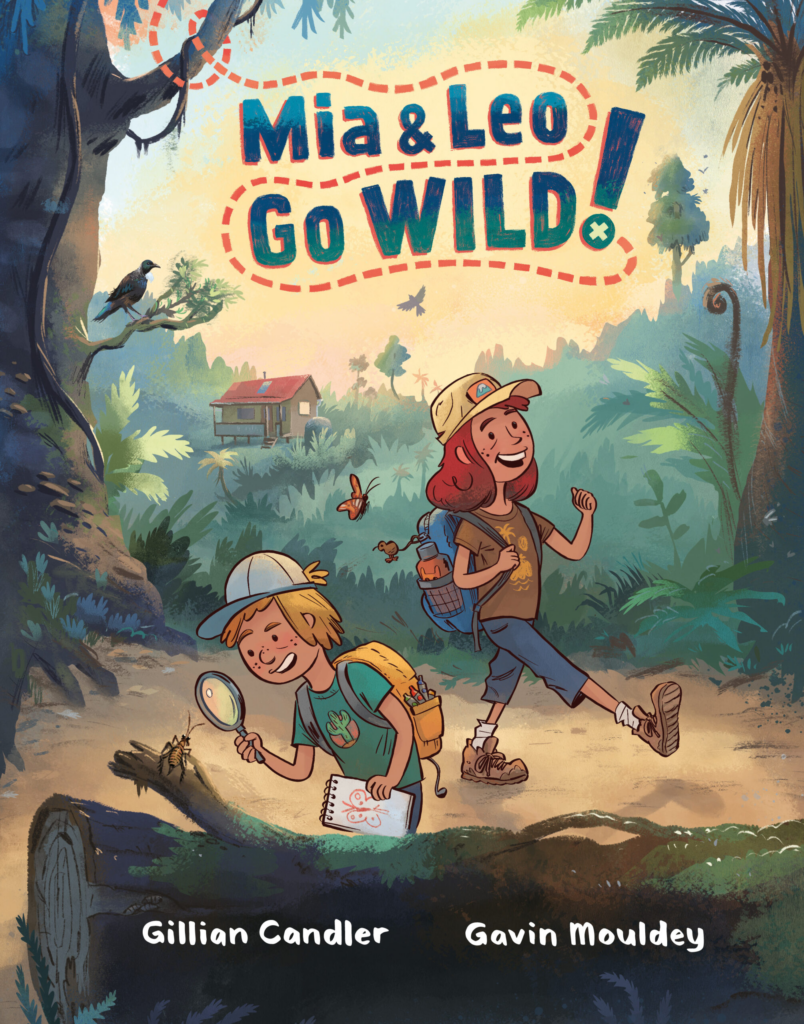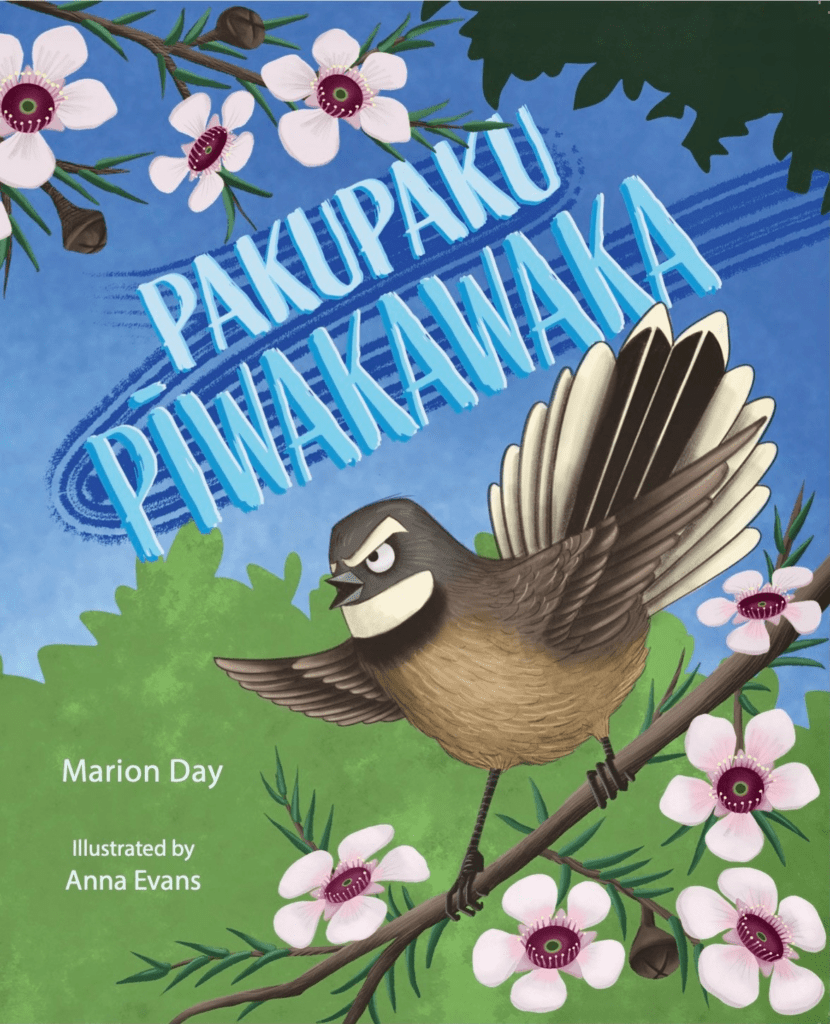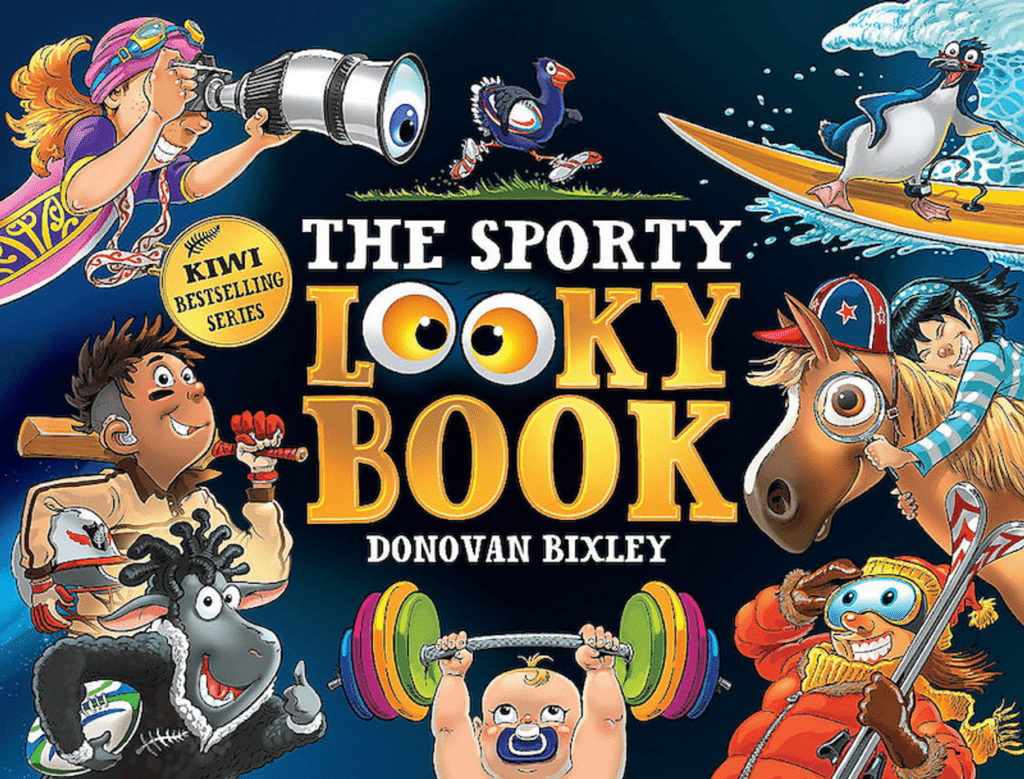Our next batch of reviews is brought to you by Kay Benseman, who offers her thoughts on five brightly illustrated picture books.

Mia and Leo Go Wild!, written by Gillian Candler and illustrated by Gavin Mouldey
Our family are fans of Gillian Candler’s non-fiction books, so I was excited to check out her newest fiction work, and this didn’t disappoint. This publication has been produced by the NZ Mountain Safety Council, and it balances dual roles as a picture book and an education resource without becoming clunky. Both the author and illustrator communicate their love of heading into the ngahere with family through the joyous storyline and lush imagery. The characters are cute and relatable, and there are lovely hidden details to look out for in the illustrations and follow-up activities.
This is a beautiful book for any tamariki who love getting into the bush in Aotearoa or who want to learn more about tramping
Without knowing the background to the story’s setting when I first read it, I immediately thought of the beautiful and family-friendly Ōrongorongo track in the Remutaka Forest Park. I’ll admit to feeling fairly smug when I later read that tramping to Jans Hut on that very track with small children was part of Gillian’s inspiration for the setting of Mia & Leo Go Wild! This adventure tale includes QR codes to the Plan My Walk app and references to the NZ Land Safety Code, but this never overtakes the storytelling.
This is a beautiful book for any tamariki who love getting into the bush in Aotearoa or who want to learn more about tramping. It is a wonderful follow-up for those who enjoyed Sarina Dickson’s A Stick and a Stone. I loved the depiction of intergenerational enjoyment of te taiao and the way this builds community.

Mia and Leo Go Wild!
Written by Gillian Candler
Illustrated by Gavin Mouldey
Published by Potton & Burton
RRP: $24.99
Pakupaku Pīwakawaka, written by Marion Day and illustrated by Anna Evans
Marion Day has created a playful story about a pīwakawaka who is kaitiaki of our native flora and fauna. This wee fantail’s commitment to keeping the ngahere safe is reminiscent of the terrifying Sphinx Gate in The NeverEnding Story of my childhood. We meet a range of threats to our endangered species, from the obvious possums and stoats, to those less frequently seen in picture books; feral cats, wasps, wild goats and boars.
Marion Day has created a playful story about a pīwakawaka who is kaitiaki of our native flora and fauna
It’s great to see te reo Māori incorporated within the text, though some kupu may not be well-known and require the reader to hop into a papakupu/dictionary. There’s no information offered about the involvement of registered translators and perhaps the grammatically-odd title of the book demonstrates this. Tāne Mahuta, Māori atua of the forest and birds, child of Papatūānuku and Ranginui, is depicted on the first page with mataora. However, I can’t find any information about the author or illustrator to clarify if they have Māori whakapapa, nor any mention of Māori artists or consultants they may have worked with on this self-published book. Which, in turn, raises questions about why Tāne is featured and the cultural safety of this — and why we are still asking this in 2023. This highlights the importance of creatives being clear about their positionality and how critical it is to respect the pūrākau cared for by iwi Māori for generations.
The book is full of detailed and fresh illustrations and my tamariki enjoyed flipping back and forth through the pages to identify each mokomoko and pekapeka. I am so pleased that the naturally emotive ‘eyebrow’ markings of the pīwakawaka have been used to communicate the bird’s indignation and disgust—absolutely on fleek.

Pakupaku Pīwakawaka
Written by Marion Day
Illustrated by Anna Evans
Published by Marion Day
RRP: $25.00
Tawatawa 1st XV, written by Hannah Abrams and illustrated by Joni Dawson
This quirky tale of a team of rugby-playing dogs is based on the author’s real life experiences at her local dog park. The watercolour illustrations depict these fluff-balls in a blur of slobbery action, and the story of their raucous morning social footie game is told in rhyme. Abrams uses rugby-specific vocabulary that may be a great primer for the Rugby World Cup but does make it a bit tricky to follow for any tamariki who aren’t already rugby fans.
My children jumped to name each dog breed they could recognise or to determine who was who. Meanwhile, I kept wondering how the game had gone on for so long without any of the kurī puncturing the football with their teeth. I found the rhyming a bit laborious at times, but the absurdity and playfulness of this fun, energetic tale had my family giggling throughout.
“While Steve pulls the ball from the gorse with a rake,
The team grab a quick wharepaku break.
Such relief when they’re done, and they’ve had a good leak,
But now half the team have gone down to the creek!”

Tawatawa 1st XV
Written by Hannah Abrams
Illustrated by Joni Dawson
Published by David Bateman Ltd
RRP: $21.99
The Sporty Looky Book, by Donovan Bixley
Another Donovan Bixley book full of his signature imagery that glows with busy details to occupy the minds of any curious tamariki. This fourth Looky Book is themed around hākinakina/sport, and it includes a full flyleaf visual dictionary of related te reo Māori vocabulary.
I love that these books have so much distinctly local visual language
As I pore over each page with my tamariki, searching for clues and hidden details, I get Where’s Wally flashbacks and I love that these books have so much distinctly local visual language. Like many of Donovan’s books, this Sporty Looky Book would be brilliant for young readers who are not drawn to books with pages upon pages of text. Even for my tamariki (who use whutupōro/rugby/soccer/football interchangeably to describe any sport that involves kicking a ball), The Sporty Looky Book was appealing on a rainy afternoon and a long car trip. It’s lovely for sharing with children who aren’t reading independently yet. Young readers will enjoy seeing some familiar characters from Donovan’s other books and solving puzzles to keep boredom at bay.

The Sporty Looky Book
Written and illustrated by Donovan Bixley
Published by Hachette
RRP: $27.99
Saving the Sun, written by Emma Pearl and illustrated by Sara Ugolotti
Following Emma Pearl’s debut picture book Mending the Moon), we meet Luna and her grandfather, Poppy, again in Saving the Sun. Both books are illustrated by Sara Ugolotti, and the gorgeously rich palette and adorable characters make this book a beautiful experience. Nocturnal creatures of the sea, land and sky appear on each page, and the images have a dreamy feel to them.
The gorgeously rich palette and adorable characters make this book a beautiful experience
We encounter Poppy and his mokopuna on a holiday that is interrupted by a cosmic disaster. The island’s feathered, furry and flippered friends join in the rescue of the overheated sun, which perhaps sets the scene for some great climate crisis conversations with tamariki. Author Emma Pearl is British, having moved to Aotearoa in recent years, which may go some way to explaining the near-miss this book makes of referencing the well-known Māori pūrākau of Māui slowing down Tamanuiterā.
The relationship between Luna and her koroua is lovely; Mending the Moon and this sequel would be brilliant for any grandchildren who are raised by their grandparents. The story itself introduced language that extended my eldest’s vocabulary but was suitable for a shared reading experience. Reading Saving the Sun prompted pātai in our whānau about horizon lines, orbits and planet axes. I had to relieve the fruit bowl of tangelos and limes to clumsily demonstrate the entire solar system, which made a possibly educational and certainly entertaining end to storytime.

Saving the Sun
Written by Emma Pearl
Illustrated by Sara Ugolotti
Published by Page Street Publishing Co.
RRP: $38.00

Kay Benseman
Kay Benseman (she/her) is a collector of quirky children's books and kupu hou. In the 90s, she worked in a bookshop and had a 40% staff discount, and her bookshelves have never recovered. With a background in education and the cultural sector, she is now a writer/researcher and Māmā to two curious children. He tāngata Tiriti ia, Kay is Pākehā living on Ngā Rauru whenua in Whanganui.



